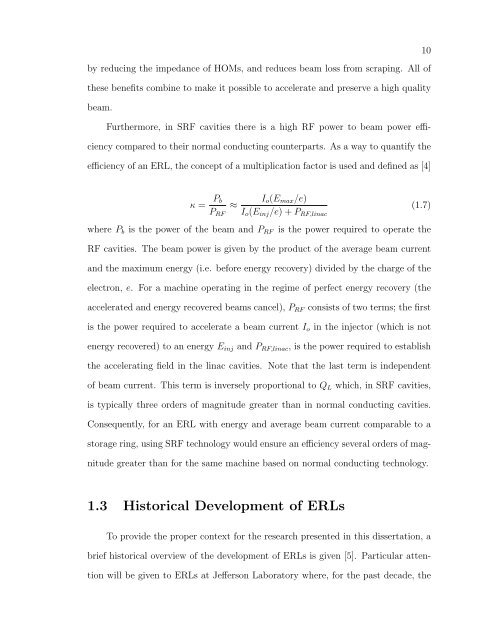STUDIES OF ENERGY RECOVERY LINACS AT ... - CASA
STUDIES OF ENERGY RECOVERY LINACS AT ... - CASA
STUDIES OF ENERGY RECOVERY LINACS AT ... - CASA
You also want an ePaper? Increase the reach of your titles
YUMPU automatically turns print PDFs into web optimized ePapers that Google loves.
y reducing the impedance of HOMs, and reduces beam loss from scraping. All of<br />
these benefits combine to make it possible to accelerate and preserve a high quality<br />
beam.<br />
Furthermore, in SRF cavities there is a high RF power to beam power effi-<br />
ciency compared to their normal conducting counterparts. As a way to quantify the<br />
efficiency of an ERL, the concept of a multiplication factor is used and defined as [4]<br />
κ = Pb<br />
PRF<br />
≈<br />
Io(Emax/e)<br />
Io(Einj/e) + PRF,linac<br />
10<br />
(1.7)<br />
where Pb is the power of the beam and PRF is the power required to operate the<br />
RF cavities. The beam power is given by the product of the average beam current<br />
and the maximum energy (i.e. before energy recovery) divided by the charge of the<br />
electron, e. For a machine operating in the regime of perfect energy recovery (the<br />
accelerated and energy recovered beams cancel), PRF consists of two terms; the first<br />
is the power required to accelerate a beam current Io in the injector (which is not<br />
energy recovered) to an energy Einj and PRF,linac, is the power required to establish<br />
the accelerating field in the linac cavities. Note that the last term is independent<br />
of beam current. This term is inversely proportional to QL which, in SRF cavities,<br />
is typically three orders of magnitude greater than in normal conducting cavities.<br />
Consequently, for an ERL with energy and average beam current comparable to a<br />
storage ring, using SRF technology would ensure an efficiency several orders of mag-<br />
nitude greater than for the same machine based on normal conducting technology.<br />
1.3 Historical Development of ERLs<br />
To provide the proper context for the research presented in this dissertation, a<br />
brief historical overview of the development of ERLs is given [5]. Particular atten-<br />
tion will be given to ERLs at Jefferson Laboratory where, for the past decade, the
















